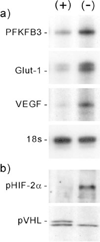Hypoxia-inducible factor-1-mediated expression of the 6-phosphofructo-2-kinase/fructose-2,6-bisphosphatase-3 (PFKFB3) gene. Its possible role in the Warburg effect
- PMID: 11744734
- PMCID: PMC4518871
- DOI: 10.1074/jbc.M110978200
Hypoxia-inducible factor-1-mediated expression of the 6-phosphofructo-2-kinase/fructose-2,6-bisphosphatase-3 (PFKFB3) gene. Its possible role in the Warburg effect
Abstract
One of the key mediators of the hypoxic response in animal cells is the hypoxia-inducible transcription factor-1 (HIF-1) complex, in which the alpha-subunit is highly susceptible to oxygen-dependent degradation. The hypoxic response is manifested in many pathophysiological processes such as tumor growth and metastasis. During hypoxia, cells shift to a primarily glycolytic metabolic mode for their energetic needs. This is also manifested in the HIF-1-dependent up-regulation of many glycolytic genes. Paradoxically, tumor cells growing under conditions of normal oxygen tension also show elevated glycolytic rates that correlate with the increased expression of glycolytic enzymes and glucose transporters (the Warburg effect). A key regulator of glycolytic flux is the relatively recently discovered fructose-2,6-bisphosphate (F-2,6-P2), an allosteric activator of 6-phosphofructo-1-kinase (PFK-1). Steady state levels of F-2,6-P2 are maintained by the bifunctional enzyme PFK-2/F2,6-Bpase, which has both kinase and phosphatase activities. Herein, we show that one isozyme, PFKFB3, is highly induced by hypoxia and the hypoxia mimics cobalt and desferrioxamine. This induction could be replicated by the use of an inhibitor of the prolyl hydroxylase enzymes responsible for the von Hippel Lindau (VHL)-dependent destabilization and tagging of HIF-1 alpha. The absolute dependence of the PFKFB3 gene on HIF-1 was confirmed by its overexpression in VHL-deficient cells and by the lack of hypoxic induction in mouse embryonic fibroblasts conditionally nullizygous for HIF-1 alpha.
Figures




References
Publication types
MeSH terms
Substances
Grants and funding
LinkOut - more resources
Full Text Sources
Other Literature Sources
Molecular Biology Databases
Miscellaneous

